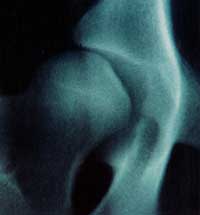 |
CAUSES If HD was caused by a single factor then it
would have been fully under stoodand largely overcome by now.
It is known that two factors determine whether HD is to occur
and, if so, how bad it will be - inheritance and what is termed
'environment'. The former relates to the genetic code passed
to the off springby both parents and the latter to all the
outside influences which alter and mould the growth and functions
of the bones, cartilage, ligaments, tendonsand muscles of
the body. In simplistic terms the genetic code is rather like
the architect's building blueprints and, the environment,
the builders and their materials. In HD the architect gets
things wrong to a greater or lesser extent but the builders
havethe greater influence on how things look and function
in the final analysis.
TREATMENT Alleviating some or most of the signs of
pain and limitation of movementcaused by HD is made possible
due to sophisticated medicines and surgery. Applied heat,
massage, good bedding and correct exercise also play a part
incaring for a dog with HD. Professional advice is always
necessary to ensurethe right combination of the rapies is
applied.
--------------------------------------------------------
|
| HOW DO I GET MY DOG'S HIPS X-RAYED? An
owner should make an appointment with their veterinary surgeon
for hip radiography to be carried out under the scheme. This
may require admission to the veterinary practice for a short
period or a day. Sedation or general anaesthesia will be required
since the manual restraint of animals during radiography is
only permitted under exceptional circumstances. Additionally,
the radiograph must be of the highest photographic quality and
the projection of all the required structures must be as dictated
by the rules of the scheme (copies of which are available from
theBVA).The advice of the practice staff should be followed
regarding any period of 'nilby mouth', the time of the appointment
and the need in every case to presentat the time of the procedure
the Kennel Club registration and, if appropriate, transfer certificates.
It is a requirement of the scheme that the registration number
is indelibly printed on to the radiograph. It will be necessary
for the owner of the dog or his agent to sign the scoring sheet
there by signifying the identity of the animal in question and
associated details, giving permission forthe results to be published
and to be subjected to genetical and statistical research.The
minimum age of the dog at the time of the radiography is 12
months; there is no upper age limit. Dogs may not be scored
under the scheme more than once.The cost of the procedure will
be a composite of the veterinary surgeon's feefor taking the
radiograph and the fee forwarded with the film to the BVA. The
latter covers the fees paid to the scrutineers appointed under
the scheme, are imbursement of costs incurred by the Kennel
Club and an administration charge made by the BVA. |








